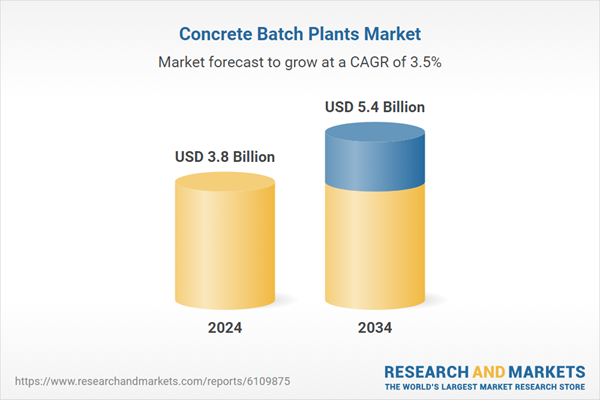Mobile batching plants are gaining notable traction due to their on-site mixing capability, which reduces the reliance on transportation and speeds up project timelines. This demand spans across various sectors, including utilities, industrial development, and road construction. Evolving environmental policies and growing emphasis on sustainable construction are prompting contractors to consider electric-powered mobile plants over diesel-based alternatives, particularly in dense urban areas. Compact modular plants with portable features are increasingly being adopted for their ease of relocation and set-up flexibility. Furthermore, innovations like IoT integration, automation, and smart control panels are transforming plant operations, making real-time monitoring and minimal manual input possible.
The wet concrete mix segment generated USD 2.6 billion in 2024 and is expected to grow at a CAGR of 3.7% from 2025 to 2034. Wet mix plants are gaining more preference as they allow all essential materials - including water - to be thoroughly mixed at the site before the concrete is loaded for delivery. This results in a more even mix and superior concrete quality, which appeals to construction professionals seeking consistency and reliability. Compared to dry batch plants that deliver pre-weighed materials for mixing in transit, wet mix systems offer greater control and uniformity, especially in larger projects requiring higher strength specifications. While dry mix solutions are useful for fast-moving, remote construction tasks, wet batching remains dominant for its better results and production precision.
Plants with a production capacity ranging from 30 to 80 m³/h segment accounted for 47% share in 2024 and are projected to register a CAGR of 3.9% during 2025-2034. These batch plants are ideally suited for medium-scale infrastructure developments and urban projects, balancing capacity with flexibility. Their moderate throughput enables contractors to deploy them for a wide range of applications such as commercial developments, municipal projects, and road paving operations. They strike a good balance between output efficiency and mobility, allowing users to adapt quickly to different project requirements.
Europe Concrete Batch Plants Market was valued at USD 800 million in 2024 and is anticipated to grow at a CAGR of 3.1% from 2025 to 2034. This regional growth is being shaped by regulatory pressure to cut construction emissions and the rising demand for sustainable building practices. Contractors throughout Europe are adopting mobile batch plants to reduce the environmental footprint of transporting concrete and to better align with eco-focused infrastructure initiatives. Western Europe sees steady demand supported by refurbishment and maintenance activities, while in Eastern Europe, the market is expanding rapidly due to public and private investment in infrastructure growth and emerging construction demands. Countries across the region are making sustainability central to development strategies, pushing the adoption of newer-generation concrete batching systems.
Key manufacturers leading the market include Sany, Elkon, Vince Hagan, Putzmeister, XCMG, Cemco, Meka, JEL Concrete Plants, SCHWING Stetter, Semix, Stephens Mfg, Ammann, AIMIX Group, Liebherr, and Astec. Top players in the concrete batch plants market are deploying several focused strategies to strengthen their competitive edge and enhance market share. Companies prioritize product innovation with a strong emphasis on automation and digital integration to deliver smart batching solutions with real-time control features. They are introducing energy-efficient models to align with sustainability trends and meet emission norms. Regional expansion through partnerships and localized manufacturing is helping firms improve market responsiveness and reduce logistics costs. Modular and portable plant designs are being emphasized to serve remote projects and fast-paced construction sites.
Comprehensive Market Analysis and Forecast
- Industry trends, key growth drivers, challenges, future opportunities, and regulatory landscape
- Competitive landscape with Porter’s Five Forces and PESTEL analysis
- Market size, segmentation, and regional forecasts
- In-depth company profiles, business strategies, financial insights, and SWOT analysis
This product will be delivered within 2-4 business days.
Table of Contents
Companies Mentioned
- AIMIX Group
- Ammann
- Astec
- Cemco
- Elkon
- JEL Concrete Plants
- Liebherr
- Meka
- Putzmeister
- Sany
- SCHWING Stetter
- Semix
- Stephens Mfg
- Vince Hagan
- XCMG
Table Information
| Report Attribute | Details |
|---|---|
| No. of Pages | 220 |
| Published | June 2025 |
| Forecast Period | 2024 - 2034 |
| Estimated Market Value ( USD | $ 3.8 Billion |
| Forecasted Market Value ( USD | $ 5.4 Billion |
| Compound Annual Growth Rate | 3.5% |
| Regions Covered | Global |
| No. of Companies Mentioned | 15 |









